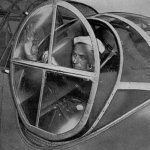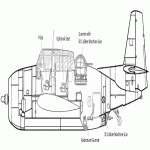The North American F-107 is North American Aviation's entry in a United States Air Force tactical fighter-bomber design competition of the 1950s. The F-107 was based on the F-100 Super Sabre, but included many innovations and radical design features, notably the over-fuselage air intakes. The competition was eventually won by the Republic F-105 Thunderchief, and most of the F-107 prototypes ended their lives as test aircraft. One is on display at the National Museum of the United States Air Force and a second at Pima Air and Space Museum.
Design and development
In June 1953, North American initiated an in-house study of advanced F-100 designs, leading to proposed interceptor (NAA 211: F-100BI denoting "interceptor") and fighter-bomber (NAA 212: F-100B) variants.[2] Concentrating on the F-100B, the preliminary engineering and design work focused on a tactical fighter-bomber configuration, featuring a recessed weapons bay under the fuselage and provision for six hardpoints underneath the wings. Single-point refuelling capability was provided while a retractable tailskid was installed.[3] An all-moving vertical fin and an automated flight control system were incorporated which permitted the aircraft to roll at supersonic speeds using spoilers.[4] The flight control system was upgraded by the addition of pitch and yaw dampers.[3]
A side-view of North American F-107A, AF Ser. No. 55-5119, at the NMUSAF.
The aircraft's most distinguishing feature is its dorsal-mounted variable-area inlet duct (VAID). While the VAID was at the time a system unique to the F-107A, it is now considered to be an early form of variable geometry intake ramp which automatically controlled the amount of air fed to the jet engine.[5] Although the preliminary design of the air intake was originally located in a chin position under the fuselage like the Vought F-8 Crusader, the air intake was eventually mounted in an unconventional position directly above and just behind the cockpit.[6] The VAID system proved to be very efficient and NAA used the design concept on their A-5 Vigilante, XB-70 Valkyrie and XF-108 Rapier designs.[7]
The air intake was in the unusual dorsal location as the Air Force had required the carriage of an underbelly semi-conformal nuclear weapon. Some sources claim that the original chin intake caused a shock wave that interfered in launching this weapon, but no such testing was actually carried out.[8] The implications this design choice had for the survivability of the pilot during ejection were troubling. The intake also severely limited rear visibility. Nonetheless this was not considered terribly important for a tactical fighter-bomber aircraft, and furthermore it was assumed at the time that air combat would be via guided missile exchanges outside visual range.[9]
A training version of the F-107 was also planned, with the designation TF-107. The fuselage in front of the cockpit would have been extended, and both cockpits would have been covered by a single large cabin hood.[10][verification needed]
In August 1954, a contract was signed for three prototypes along with a pre-production order for six additional airframes.[6]
Designation and names
Extensive design changes resulted in its redesignation from F-100B to F-107A before the first prototype flew. The F-107 was never given an official name, but was sometimes informally called the "Super Super Sabre"[11] referring to North American's earlier fighter design, the F-100 Super Sabre.[12] The flight crews referred to it as the "man eater", in reference to the position of the air intake directly above the cockpit.[13]
The designation "F-107A" was the only one assigned to the aircraft,[12][14] though "YF-107A" is often used in publications
he first F-107A (s/n 55-5118) with North American's chief test pilot Bob Baker at the controls, made its initial flight on 10 September 1956, attaining Mach 1.03.[16] Although successfully carrying out its flight, the brake chute did not deploy, which resulted in a "hot" landing with the nose gear strut breaking.[16] The aircraft first achieved Mach 2 in tests on 3 November 1956.
It was joined by the second F-107A (AF Ser. No. 55-5119), which made its first flight on 28 November 1956. It was used for weapons testing with both conventional and atomic bombs.[17] The last prototype, (AF Ser. No. 55-5120) had its maiden flight on 10 December 1956. At the conclusion of the F-107A's successful test program, the Tactical Air Command decided to hold a fly-off competition between the F-107A and the Republic F-105 which was designed to same mission requirements and used the same engine. Although the competition was close, the F-105 was selected as the new standard TAC tactical fighter. The three F-107A prototypes were relegated to test flying while the pre-production order was cancelled.[18]
In late 1957, prototypes #1 and #3 were leased to the National Advisory Committee for Aeronautics (NACA) for high-speed flight research. Aircraft #1 is now in the collection of the Pima Air & Space Museum. In September 1959, with Scott Crossfield at the controls, aircraft #3 was damaged during an aborted takeoff. The aircraft was not repaired and, ultimately, used for fire fighting training and was destroyed in the early 1960s.[19] (55-5120 was also noted to be stored in poor condition in the Tallmantz collection at Orange County Airport California in September 1970.)
Prototype #2 was never used for testing, and instead flown on 25 November 1957 to the National Museum of the United States Air Force at Wright-Patterson Air Force Base near Dayton, Ohio. This aircraft had not been completed and none of the radio navigation systems had been installed. To fly it to the museum, Major Clyde Good intended to follow an F-100 being delivered the same day. After an en route refuelling stop the two aircraft became separated, and Good was forced to follow roads to the St. Louis area when it turned dark and overcast. The aircraft was not equipped with cockpit or instrument lighting, so Good periodically flicked his Zippo lighter to read the instruments. Guessing a heading, he flew close enough to Dayton to be seen on radar at Wright-Patterson Air Force Base and was talked down to the runway. It was then that Good discovered that the landing lights had not been installed either, but he was able to successfully land the plane while using the Zippo to light the airspeed indicator through the approach.[8]


Russians like it too. rear end ant delta wings make it seem to be a converted Mig 21. Carnard in the front seems interesting.
















































































